
eBook - ePub
Early American Country Homes
Tim Tanner
This is a test
Partager le livre
- 160 pages
- English
- ePUB (adapté aux mobiles)
- Disponible sur iOS et Android
eBook - ePub
Early American Country Homes
Tim Tanner
Détails du livre
Aperçu du livre
Table des matières
Citations
À propos de ce livre
Twenty restored or renovated Early American country homes feature the myriad of different styles from around the country. The homes exude a simplicity that is somewhat rustic and somewhat country in an understated way. Tim Tanner also features some small cabins that have been made livable for today as well as decorating ideas and outbuildings. Early American Country Homes is an inspiration and resource for those who are interested in building, re-creating, restoring, or just enjoying a return to simpler styling in home design.
Foire aux questions
Comment puis-je résilier mon abonnement ?
Il vous suffit de vous rendre dans la section compte dans paramètres et de cliquer sur « Résilier l’abonnement ». C’est aussi simple que cela ! Une fois que vous aurez résilié votre abonnement, il restera actif pour le reste de la période pour laquelle vous avez payé. Découvrez-en plus ici.
Puis-je / comment puis-je télécharger des livres ?
Pour le moment, tous nos livres en format ePub adaptés aux mobiles peuvent être téléchargés via l’application. La plupart de nos PDF sont également disponibles en téléchargement et les autres seront téléchargeables très prochainement. Découvrez-en plus ici.
Quelle est la différence entre les formules tarifaires ?
Les deux abonnements vous donnent un accès complet à la bibliothèque et à toutes les fonctionnalités de Perlego. Les seules différences sont les tarifs ainsi que la période d’abonnement : avec l’abonnement annuel, vous économiserez environ 30 % par rapport à 12 mois d’abonnement mensuel.
Qu’est-ce que Perlego ?
Nous sommes un service d’abonnement à des ouvrages universitaires en ligne, où vous pouvez accéder à toute une bibliothèque pour un prix inférieur à celui d’un seul livre par mois. Avec plus d’un million de livres sur plus de 1 000 sujets, nous avons ce qu’il vous faut ! Découvrez-en plus ici.
Prenez-vous en charge la synthèse vocale ?
Recherchez le symbole Écouter sur votre prochain livre pour voir si vous pouvez l’écouter. L’outil Écouter lit le texte à haute voix pour vous, en surlignant le passage qui est en cours de lecture. Vous pouvez le mettre sur pause, l’accélérer ou le ralentir. Découvrez-en plus ici.
Est-ce que Early American Country Homes est un PDF/ePUB en ligne ?
Oui, vous pouvez accéder à Early American Country Homes par Tim Tanner en format PDF et/ou ePUB ainsi qu’à d’autres livres populaires dans Architettura et Design e architettura. Nous disposons de plus d’un million d’ouvrages à découvrir dans notre catalogue.
Informations
Sujet
ArchitetturaSous-sujet
Design e architetturaGenerations of Living

Restored Originals
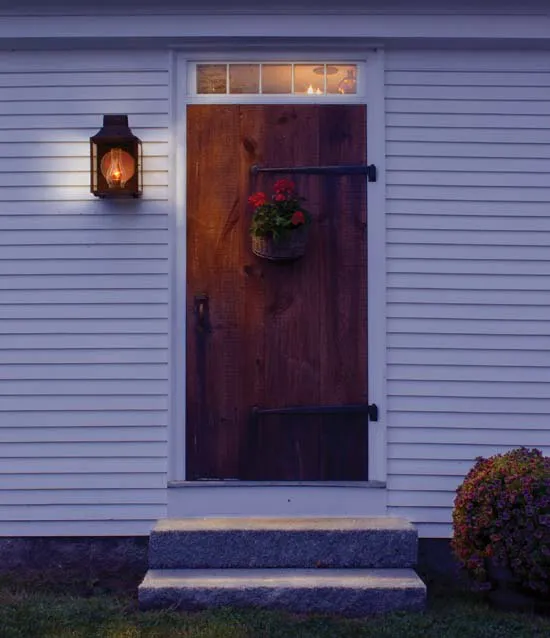
Connected to the Past
Libbey Home, York County, Maine ca. 1770
It is the quintessential New England experience: driving through winding backroads of beautiful deciduous forests, the smell of musty oak and hemlock, with 200-year-old stone fences and white church houses on town greens—to arrive at the home of Roger and Sylvia Libbey. Records date members of the Libbey family in the area back to the 1690s. Many generations of Libbeys were born within walking distance of here. Prior to purchasing the old family home, Roger and Sylvia had lived their entire married life in another old home—the same one where Sylvia had spent her childhood.
Roger has memories of their current residence from the time that he was a young boy, when it belonged to a cousin, Vernor. Amazingly, only two families have occupied the home throughout its existence. A family named Hardison were the original inhabitants, owning a gristmill and sawmill a few hundred yards away that date to 1774. The Libbey family purchased the property in 1849, with Roger and Sylvia now being the sixth generation of Libbeys to inhabit the old, wonderful dwelling, known in New England parlance as an “extended cape.”
Cousin Vernor one day related to Roger that he hated to think of what would happen to the old homestead after he was gone. Roger offered that day to purchase it and be its caretaker—then went home and told Sylvia about their new residence!
Roger and Sylvia have, in the ensuing years, completed a major renovation of the home from the ground up. Structural concerns were addressed. Fireplaces were rebuilt using original materials. Doors and windows have been restored to their earlier configurations. Post-1770 walls were removed. Exterior clapboards and interior plastering was restored. Original woodwork and flooring were mostly intact and simply needed repairs or paint. What was once a crude, dirt-floored woodshed now houses modern plumbing. A pre-1770 saltbox addition—moved from another location—was also restored.
“I often think of and feel gratitude for Vernor and his predecessors in this home—if it wasn’t for them, we wouldn’t have the joy that it brings to us now,” said Roger. “I think of them walking across these floors, living in this space, and I feel an indescribable connection to them.” It is certain that the Libbey ancestors would feel gratitude as well for Roger and Sylvia’s homage to them: their current stewardship for this special home.

A guest bedroom in the Libbey home, with furniture original to the early 1800s.
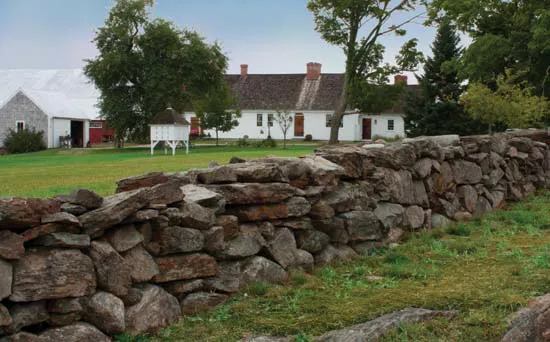
New England wouldn’t be New England without its stone fences and colonial homes.
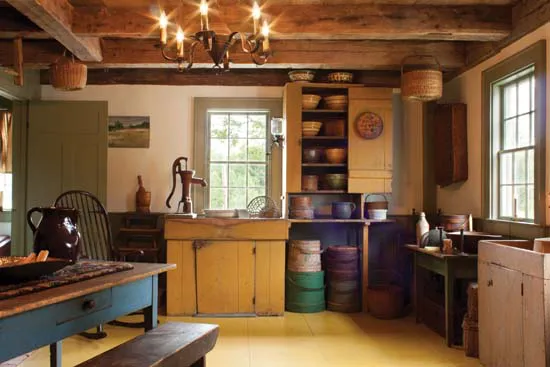
Three articles of cabinetry are original to the home (though they weren’t here when Roger and Sylvia purchased the home). This interesting mustard-colored piece is one of them.
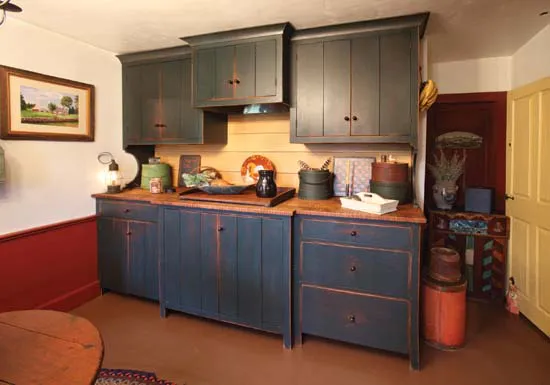
A view of the David T. Smith kitchen in the Libbey Home. You will see many examples of David’s work throughout this book. Photograph © 2011 Brian Brown.
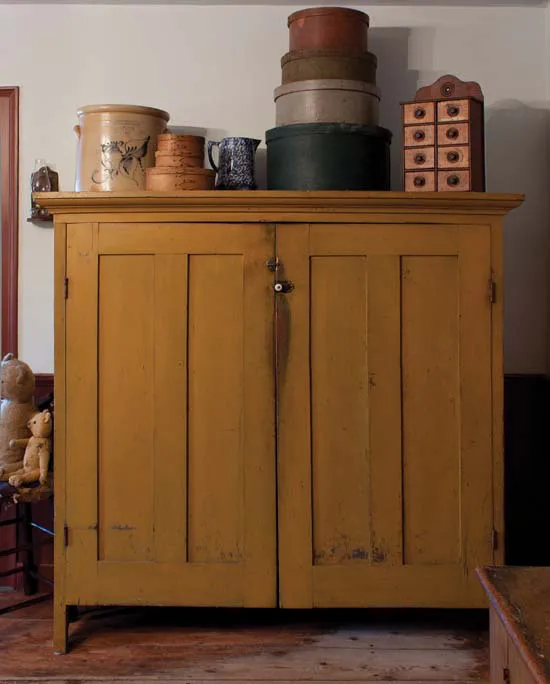
This cabinet is original to the home. Six generations of the Libbey family have opened and closed these doors.
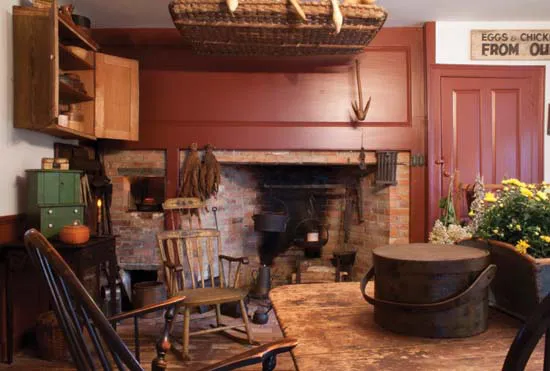
The hearth in the keeping room—complete with bake oven and fireplace crane. Countless hours were spent, centuries ago, cooking at this hearth.

The Libbey kitchen is one of the most famous works of David T. Smith. It was inspired by an early 1800s kitchen original to Maine, yet found in Atlanta, Georgia. Photograph © 2011 Brian Brown.
A Colonial Tavern
Bonin Home (Samuel Waters Tavern), Sutton, Massachusetts ca. 1775
The Samuel Waters Tavern is a remarkable little piece of history tucked into the center of New England, fronting one of the many old turnpikes common to Massachusetts. The tavern was constructed around 1775 by Mr. Samuel Waters and his wife Prudence. The property was used not only as a tavern and a private residence, but at one time in its history it was also used as a meeting house for a local group of Freemasons.
The quaint New England home has been a witness to colorful history throughout its more than 235 years of existence, including the residence of a pair of “maiden ladies” and a noted woman suffragist, Lucy Phelps. Lucy’s signature can still be found on many of the walls in the upstairs ballroom of the tavern.
Bill and Cheryl Bonin grew up in neighboring areas not far from Sutton. While Cheryl was growing up, her family also resided in West Virginia for a period, in an old Victorian farmhouse. There she grew to appreciate the antique woodwork, unique character, and comfortable ambiance of a historic structure. As an adult, Cheryl returned to New England, married Bill, and soon became an avid collector of antiques. As time passed, her primitive antique collection grew, and their 1970s house grew more and more out of place. Cheryl longed for an old home to complete the picture, and in 2006, Bill, Cheryl, and daughter Alex were able to find the perfect structure to house the primitive antique collection—the old Samuel Waters Tavern.
The home had been favorably owned and restored by carpenter David Stevenson, who had done a fantastic ...